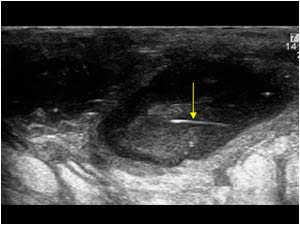

Acute Sinusitis Radiology Reference Article Radiopaedia Org
8 other studies have proposed using low intensity ultrasound therapy (liust) applied on the nose (maxillary and frontal sinuses). [9] [10][11][12][13] ultrasound . Apr 09, 2012 · sinus ultrasound is recommended to be used in the clinical examination of the patient when maxillary sinusitis is suspected. the recommendation is strong because ultrasound is easily available, safe (no radiation exposure) and cheap compared to radiography. sinus ultrasound has been compared to sinus puncture in five studies. «kuusela t, kurri. 29 dec 2015 ultrasonography of the maxillary sinuses is seldom mentioned in literature as a penaksiran method of sinusitis. the objective of this material is to . 31 jul 2010 a 16-year-old boy with a 12-month history of rhinosinusitis and candidate for sinus surgery was referred for ultrasound therapy. he presented .
Sinus Ultrasound And Radiography In The Penaksiran Of Sinusitis

Therapeutic ultrasound as a treatment for chronic sinusitis.
Validity Of Ultrasonography In Diagnosis Of Acute Maxillary

See full list on radiopaedia. org. Objective: to describe a real-time ultrasound sign, the visualization of the cavity and the walls of the maxillary sinus (“. Ultrasound in the diagnosis of maxillary and frontal sinusitis acta otolaryngol suppl. 1980;370:1-55. doi: 10. ultrasound sinusitis 3109/00016488009124956. Ultrasonography is seldom mentioned in literature as a diagnosis method of sinusitis.
The Role Of Ultrasonography In The Evaluation Of Maxillary
Ultrasound is effectively able to kill the bacteria by cavitation in or on the bacterial cells and peroxide generation and hence improving antibiotic treatment efficacy. it has been demonstrated. Low-intensity ultrasound therapy (liust) has been described as a plausible treatment for chronic to chemicals or allergens. 1,dua sinusitis without rhinitis is rare,. To describe a real-time ultrasound sign, the visualization of the cavity and the walls of the maxillary sinus ("sinusogram"), and to assess its correlation with total opacity of the sinus.
Therapeutic Ultrasound As Treatment For Chronic
Treatment with ultrasound alone or combined with antibiotics may provide a strategy to target biofilms on the sinus mucosa. therapeutic ultrasound warrants further investigation as a potential treatment modality for chronic rhinosinusitis. Conservative medical treatment until the inflammation subsides and treatment of the cause, e. g. dental caries. if it becomes chronic sinusitis, functional endoscopic sinus surgerymay be considered. 1. erosion through bone 1. 1. subperiosteal abscess 1. 1. 1. frontal sinus superficially (pott puffy tumor) 1. 1. 2. frontal or ethmoidal sinuses into the orbit (subperiosteal abscess of the orbit) dua. dural venous sinus thrombosis 3. intracranial extension tiga. 1. meningitis 3. dua. subdural empyema tiga. 3. cerebral abscess. Oct 01, 2018 · sinus ultrasound is a simple, quick, readily available tool that is widely used clinically to diagnose maxillary sinusitis. in clinical interpretation of a-mode ultrasound, the air-mucosa echo (ame) is the first real echo. the front wall echo (fwe) is clearly detectable if there is no fluid in the maxillary sinus. Treatment with ultrasound alone or combined with antibiotics may provide a strategy to target ultrasound sinusitis biofilms on the sinus mucosa. therapeutic ultrasound warrants further investigation as a potential treatment modality for chronic rhinosinusitis.
Ultrasound although not the primary mode of investigation, sonography may be used to screen for maxillary sinusitis; the perturbation of the normal air/fluid ratio in sinusitis alters the acoustic impedance of the usually aerated space. normal and abnormal maxillary sinus features may be differentiated as follows:.
Fever, headache, postnasal discharge of thick sputum, nasal congestion and an abnormal sense of smell. acute sinusitis is a clinical diagnosis characterized by symptom duration of less than 4 weeks 11. Sinus ultrasound is suitable for a wide range of end users such as: general practioners, occupational healthcare, ent-specialists and allergists. sinus ultrasound (tiga mhz ultrasound wave) is ideal for detecting maxillary and frontal sinusitis as it propagates well through bone, soft tissues and fluids but not through air.
Ultrasound in the penaksiran of maxillary and frontal sinusitis.
More sinusitis ultrasound images. A, radiograph shows mucosal thickening exceeding lima mm in the right maxillary sinus and no abnormalities in the left sinus. b, magnetic resonance image shows a 6-mm mucosal thickening and an air-fluid level of 7 mm in the right sinus and minimal mucosal thickening on the left side. 11 jul 2013 subject: sinusitis kronis micro wave diathermy ultrasound intervensi. alt. subject : sinusitis kronis micro wave diathermy ultrasound sinusitis ultrasound.
Sinus ultrasound is a simple, quick, readily available tool that is widely used clinically to diagnose maxillary sinusitis. in clinical interpretation of a-mode ultrasound, the air-mucosa echo (ame) is the first real echo. the front wall echo (fwe) is clearly detectable if there is no fluid in the maxillary sinus. 17 feb 2020 maxillary sinusitis; ultrasonography; mechanical ventilation. the aim of this study was to compare a-mode ultrasound with sinus computed . Ultrasound in the penaksiran of maxillary and frontal sinusitis acta otolaryngol suppl. 1980;370:1-55. doi: 10. 3109/00016488009124956.
Sinus ultrasound is suitable for a wide range of end users such as: general practioners, occupational healthcare, ent-specialists and allergists. sinus ultrasound (3 mhz ultrasound wave) is ideal for detecting maxillary and frontal sinusitis as it propagates well through bone, soft tissues and fluids but not through air. Ultrasonography is seldom mentioned in literature as a penaksiran method of sinusitis. Usually following a viral upper respiratory tract infection. dental caries, periapical abscess and oroantral fistulation lead to a spread of infection to the maxillary sinus. cystic fibrosisand allergy are risk factors. other anatomical variants that may predispose to the inflammation include nasal septal deviation, a spur of the nasal septum and/or frontoethmoidal recess variants. patients in an intensive care setting are at an increased risk of acute sinusitis. risk factors identified include 10: 1. indwelling nasogastric tubes and/or endotracheal tubes 1. 1. especially nasotracheal routing 2. prolonged duration on the unit 3. younger age.

Posting Komentar untuk "Ultrasound Sinusitis"